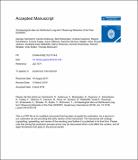Archaeological sites as Distributed Long-term Observing Networks of the Past (DONOP)
Abstract
Archaeological records provide a unique source of direct data on long-term human-environment interactions and samples of ecosystems affected by differing degrees of human impact. Distributed long-term datasets from archaeological sites provide a significant contribution to establish local, regional, and continental-scale environmental baselines and can be used to understand the implications of human decision-making and its impacts on the environment and the resources it provides for human use. Deeper temporal environmental baselines are essential for resource and environmental managers to restore biodiversity and build resilience in depleted ecosystems. Human actions are likely to have impacts that reorganize ecosystem structures by reducing diversity through processes such as niche construction. This makes data from archaeological sites key assets for the management of contemporary and future climate change scenarios because they combine information about human behavior, environmental baselines, and biological systems. Sites of this kind collectively form Distributed Long-term Observing Networks of the Past (DONOP), allowing human behavior and environmental impacts to be assessed over space and time. Behavioral perspectives are gained from direct evidence of human actions in response to environmental opportunities and change. Baseline perspectives are gained from data on species, landforms, and ecology over timescales that long predate our typically recent datasets that only record systems already disturbed by people. And biological perspectives can provide essential data for modern managers wanting to understand and utilize past diversity (i.e., trophic and/or genetic) as a way of revealing, and potentially correcting, weaknesses in our contemporary wild and domestic animal populations.
Citation
Hambrecht , G , Anderung , C , Brewington , S , Dugmore , A , Edvardsson , R , Feeley , F , Gibbons , K , Harrison , R , Hicks , M , Jackson , R , Ólafsdóttir , G Á , Rockman , M , Smiarowski , K , Streeter , R , Szabo , V & McGovern , T 2018 , ' Archaeological sites as Distributed Long-term Observing Networks of the Past (DONOP) ' , Quaternary International , vol. In press . https://doi.org/10.1016/j.quaint.2018.04.016
Publication
Quaternary International
Status
Peer reviewed
ISSN
1040-6182Type
Journal article
Description
The authors would also like to acknowledge the support of the National Science Foundation, specifically the Arctic Social Sciences Program, and RANNIS (The Icelandic Center for Research).Collections
Items in the St Andrews Research Repository are protected by copyright, with all rights reserved, unless otherwise indicated.

